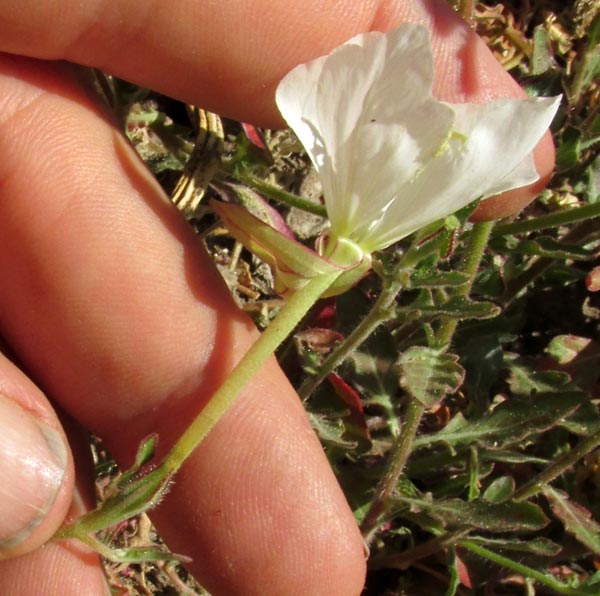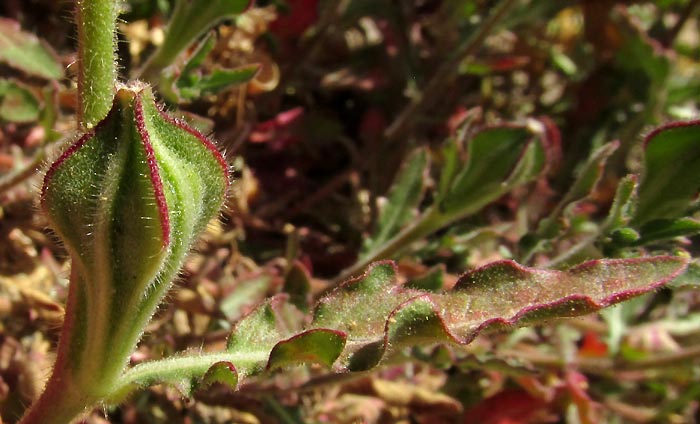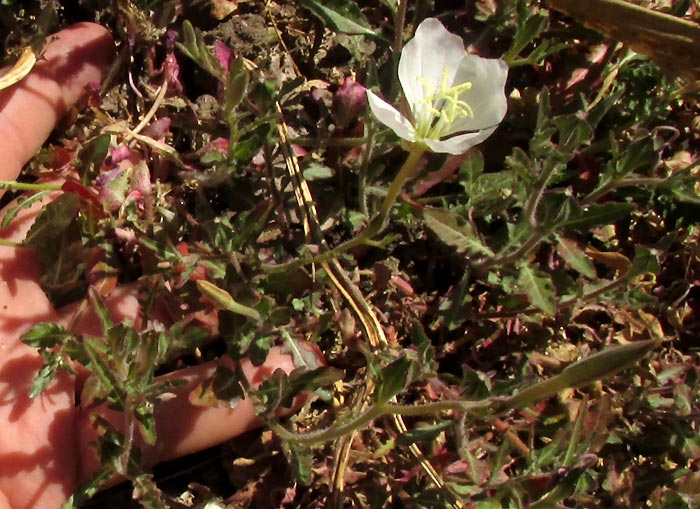Excerpts from Jim Conrad's
Naturalist Newsletter
entry dated March 28, 2022, issued from near Tequisquiapan, elevation about 1,900m (6200 ft), ~N20.57°, ~ W99.89°, Querétaro state, MÉXICO
FOURWING EVENING PRIMROSE

Now during the late dry season when fallow fields are a wreck of dried-crisp, brown and gray herbage, at the desolate edge of a weedy cornfield, the above blossom was good to see. At 10:30AM, this particular flower was the only one of several still open, despite all the others having wilted. This one remained open by virtue of being in the shadow of the tattered remains of a nearby cornstalk. The wilted blossoms made sense, because with this large flower with four corolla lobes, a conspicuously 4-lobed stigma making a cross, and 8 stamens, what could it be but a species of evening primrose, genus Oenothera, of the Evening Primrose Family, the Onagraceae? And evening primrose flowers open in the evening, then close the following morning.
Other diagnostic features of evening primrose species, of which about 52 species are recognized, are seen when we look at the blossom from its side:

Corollas of evening primroses have well developed, slender corolla tubes, up through which the sometimes very long style passes. In the picture, atop the corolla tube and below the corolla lobes, four long, slender, purple-tinged sepals are seen. Evening primrose sepals often are tinged or striped red or purple, just like these. Corolla tube length in relation to the corolla lobes is an important field mark for separating the many evening primrose species, and this species has well developed ones. Species in The Evening Primrose Family produce inferior ovaries -- corollas attached atop the ovary -- and in the above picture you can see the immature ovary where it belongs. A close-up of a more mature ovary and its attending leaf is shown below:

Several Oenothera species produce 4-angled, capsular fruits similar to this, but in this particular species the fruit angles are especially impressive, forming wings. In fact, often this species is named Fourwing Evening Primrose, which is a direct translation from its binomial name, OENOTHERA TETRAPTERA.
The leaf in the above picture is fairly typical of the evening primroses, being somewhat lobed along the margins, and tinged with red or purple. The yellow-flowered Common Evening Primrose of eastern and central North America is tall with a well developed central stem, but our Fourwing Evening Primrose tends to produce several stems that clamber along the ground, ascending at their tips only to flower and fruit. The whole arrangement looks rather messy, but that only makes the blossoms' elegant simplicity even more gorgeous. You can see the effect below, my hand intruding from the left for scale.

Fourwing Evening Primroses occur along roadsides and other disturbed sites such as the edge of our weedy cornfield, especially in moist spots, from the southern US south to northern South America, plus they are invasive in certain other countries.